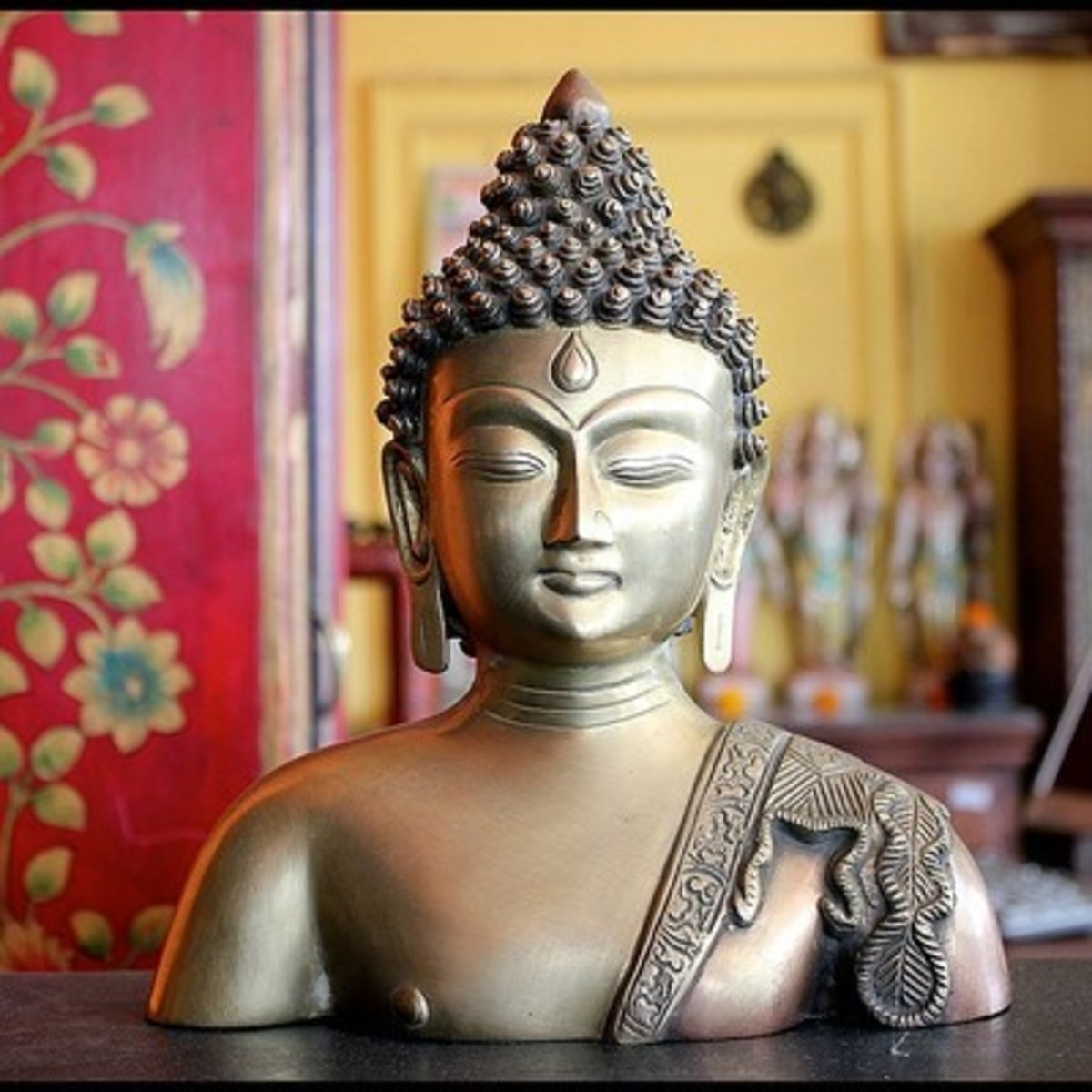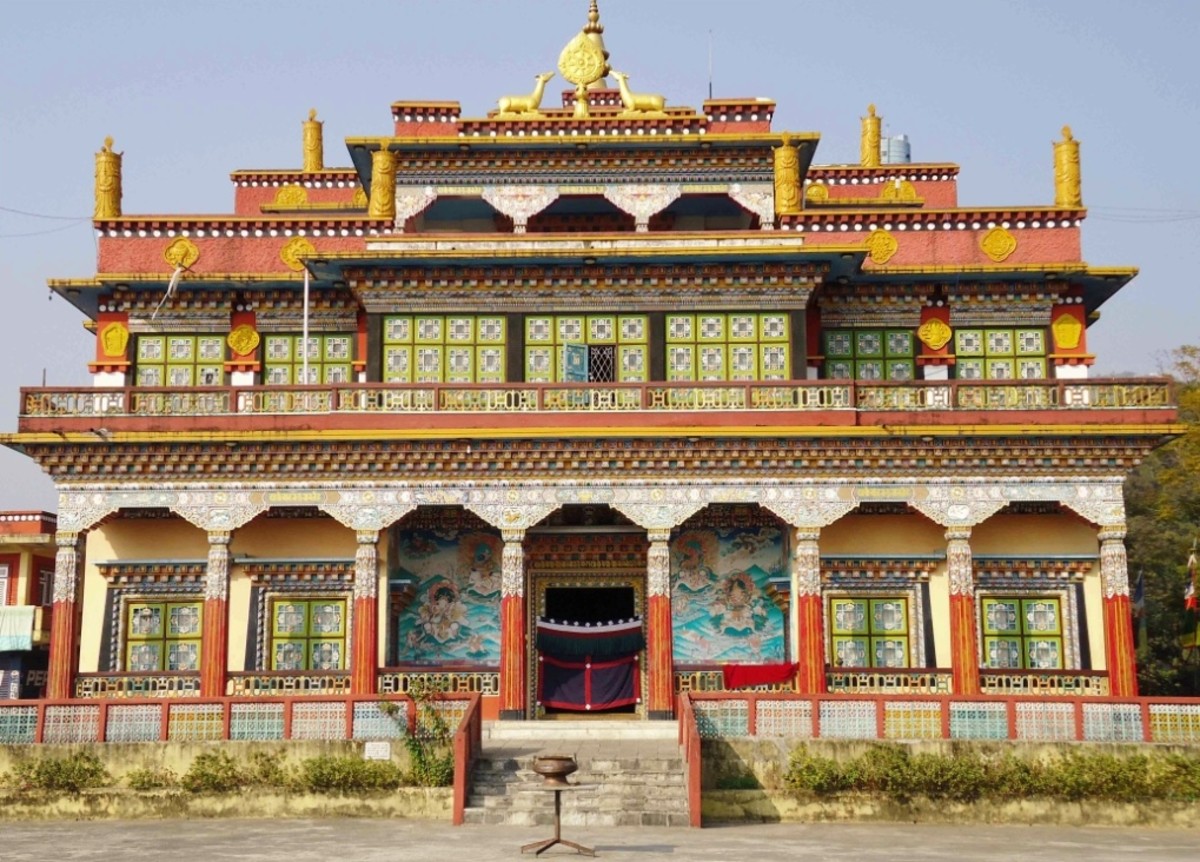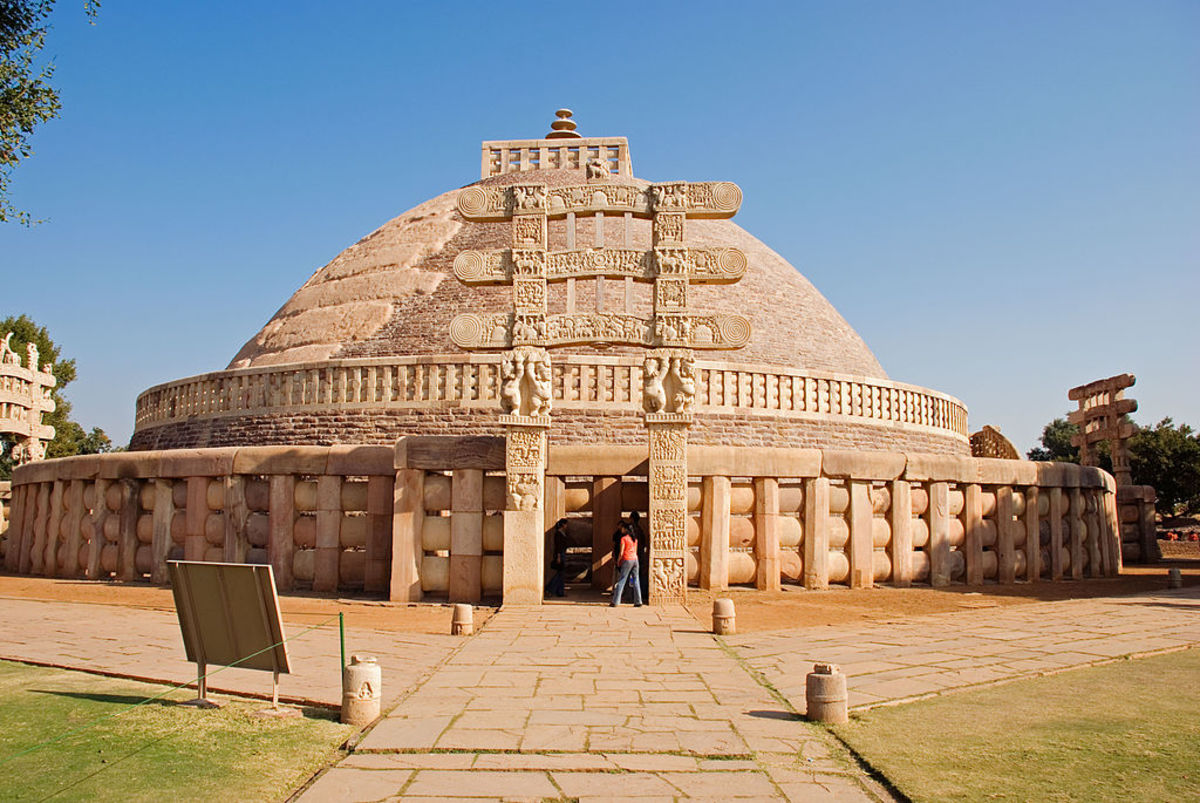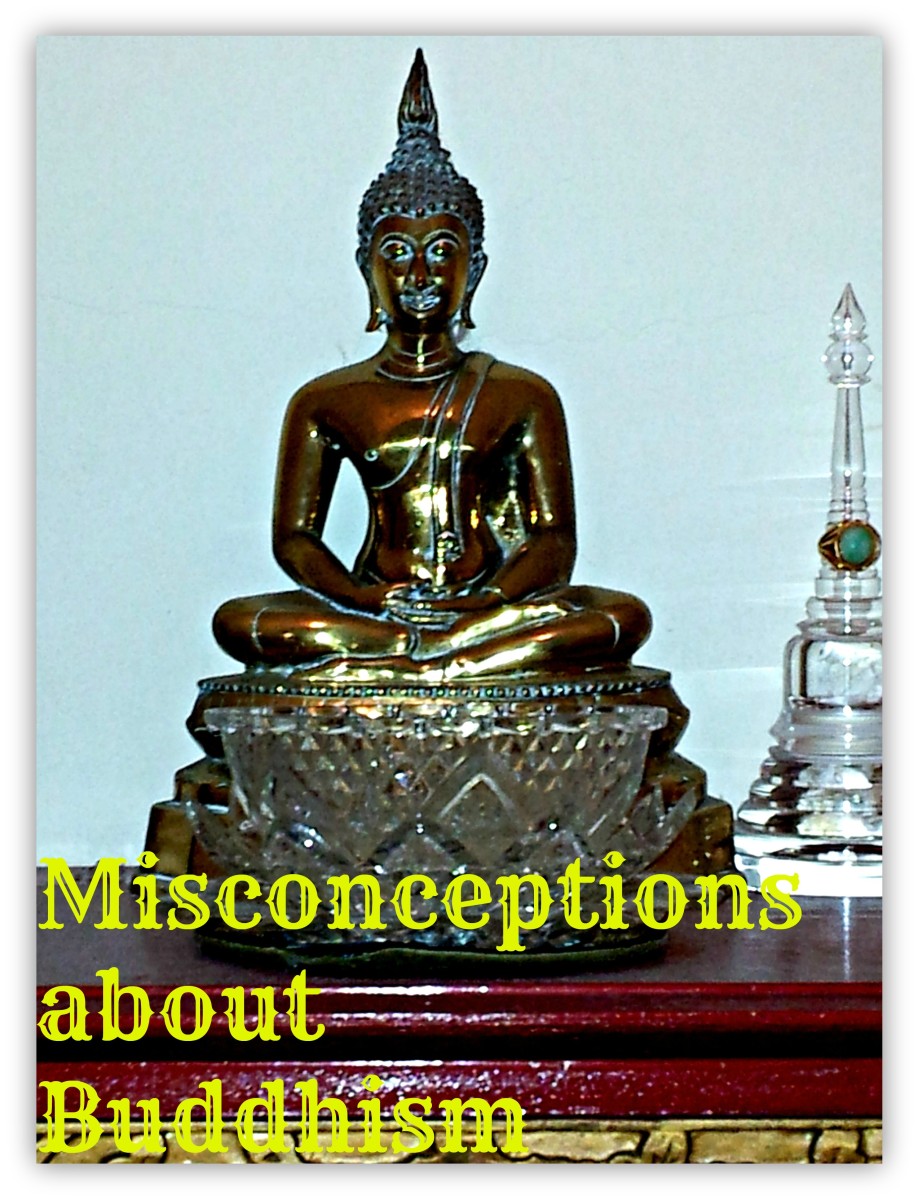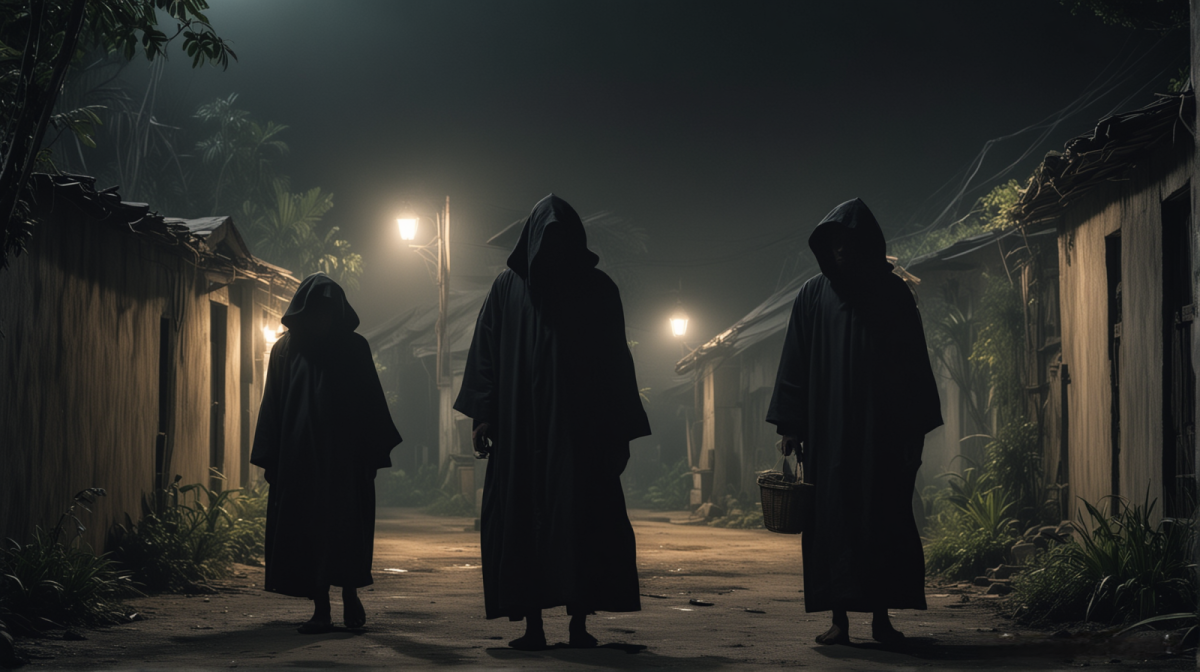Buddhism | Leshan Giant Buddha
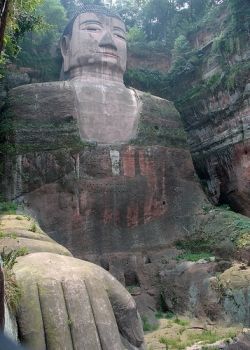
This Giant Buddha in Le Shan, Sichuan is the Largest Carved Stone Buddha in the World!
The Grand Buddha at Leshan (Sichuan Province, China) is the largest ancient stone carved image of Buddha in the world, standing 71 metres. It is located at the foot of Mt. Lingyun, where the Minjiang, Dadu and Qingyi Rivers meet. The first Buddhist temple in China was built opposite, in the 1st century CE at Mount Emei from where Buddhism first spread across China."Leshan Da Fo" was constructed in the Tang Dynasty to control dangerous currents, for flood mitigation, and worship. Every year there are around 300,000 visitors who queue up to clamber down the ancient carved cliff-steps in order to get a close view of the Buddha.
Image: drs2biz | Lens Updated: 14 Jan, 2013 @ 10:44 pm Beijing time.
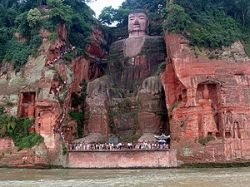
Read About Leshan Giant Buddha on Wikipedia!
Read what the on-line reference source has to say...
The Leshan Giant Buddha was built during the Tang Dynasty (618-907). It is carved out of a cliff face that lies at the confluence of the Minjiang, Dadu and Qingyi rivers in the southern part of Sichuan province in China, near the city of Leshan. The stone sculpture faces Mount Emei, with rivers flowing below...
Floral Display: "Fo" (Pronounced "four" - Buddha) at The Entrance to Leshan Giant Buddha Park!
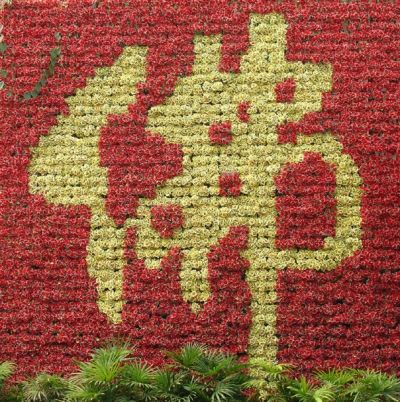
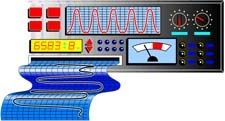
Basic Information For The Leshan Giant Buddha!
Browse details of the Giant Buddha and discover its immensity...
- Location: Lingyun Hill, east of Leshan City (Sichuan Province, China), opposite Mount Emei.
- Latitude: 29.5468 N
- Longitude: 103.7693 E
- Altitude: 385.5 metres
- Construction: Between 713 AD and 803 AD.
- Heritage Listing: UNESCO World Heritage Site, 1996.
- Total Height: 71 metres high.
- Head: 14.7 metres high, covered with 1,021 chignons.
- Ear: 6.2 metres long.
- Eye: 3.3 metres wide.
- Shoulder: 28 metres wide.
- Middle finger: 8.3 metres long.
- Feet: 11 metres long and 8.5 meters wide.
Add Your Comments
Leave a comment in our Guest Book
Leshan Giant Buddha is Huge!
Look at these images to see for yourself:
Here is The Leshan Giant Buddha's Portrait View! - The eye is a mere 3.3 m. wide and the shoulders are 28 m. across...
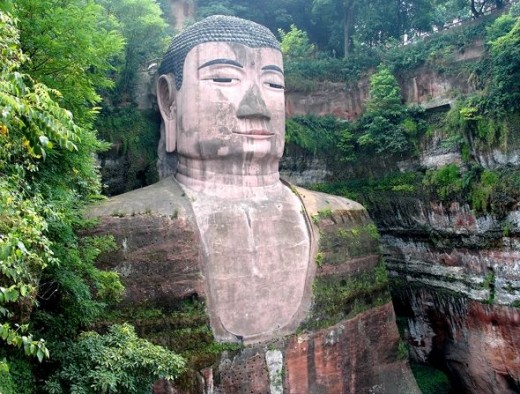
Image of Leshan Giant Buddha on Flickr by... drs2biz!
Take a Look at Leshan Giant Buddha's Hands! - The length of the middle finger is 8.3 m (yes, that's over 27 ft)...
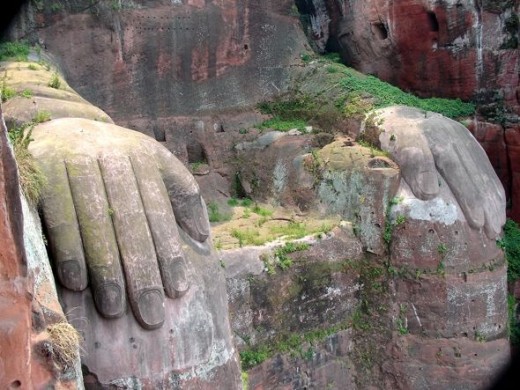
Image of Leshan Giant Buddha on Flickr by... drs2biz!
See the People at Leshan Giant Buddha's Foot! - The feet are 11 m. long and 8.5 m. wide (that's approx. 36 x 28 ft)...
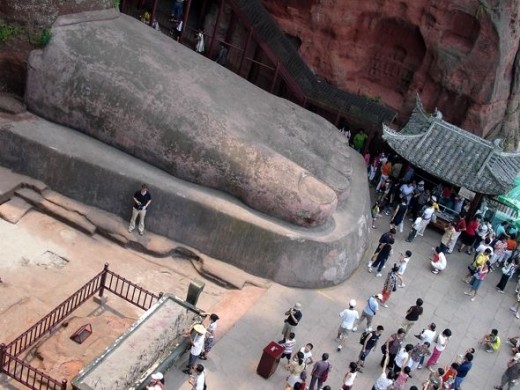
Image of Leshan Giant Buddha on Flickr by... drs2biz!
Leshan Giant Buddha's Huge Head - Side View! - The head is 14.7 m high, with 1,021 chignons. The ear is 6.2 m...
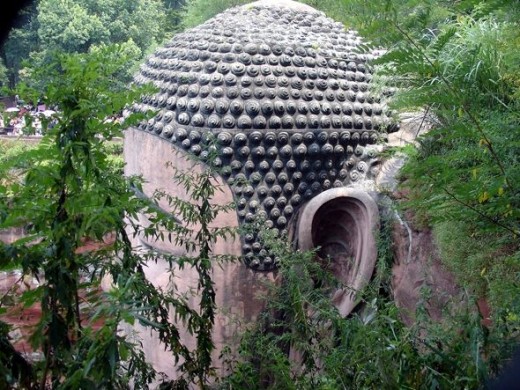
Image of Leshan Giant Buddha on Flickr by... drs2biz!
Image from beautifulcataya by Victor Segalen, 1914!
Image by drs2biz captured on August 8th, 2006!
Image by rduta captured on October 10th, 2008!
Over the centuries, the original protection for the Buddha, a wooden temple structure, has rotted away and left the figure exposed to the weather. Many restoration efforts have been undertaken, and the appearance of Maitreya has altered accordingly. Here are three views for you to compare!
In 2001, major restoration was launched, and the park was closed to the public for several months. Since then, the economy of this region has been booming, and the subsequent manufacturing plants have emitted coal fired pollutants. The image in the centre shows evidence of this.
Subsequent to the original images on this lens being captured in 2006, the Giant Buddha has undergone restoration work to alleviate environmental damage to its features. "The damage was due to acid rain, weathering and high humidity", Peng Xueyi, director of the Leshan Cultural Relics Management Institute states. The Institute is bracing itself for a five year cycle of maintenance to prevent further deterioration of the Giant Buddha. It is pleasing to note that the authorities are committed to preserving this monument, in line with its status as a UNESCO World Heritage Site!
Add Your Comments
Leave a comment in our Guest Book
It's easier to pluck out your eyes than get wealthy following Buddha!
The quote, above, is from the Buddhist monk Haitong, who was responsible for the creation of the Leshan Giant Buddha. It is said that a bureaucrat, in the time of Haitong, ordered him to hand over large amounts of money he had collected from the people for this construction project. After Haitong made this famous statement, the evil official challenged him to back up his words with action... and Haitong promptly plucked out his own eyes! This brave monk protected the money, donated for the statue, with his own life.
Troubled by the loss of life and property by the raging currents in this area, Haitong decided to enlist the aid of Matreya Buddha to calm the spirits of the water. This massive project was finally completed, 90 years after it was commenced.
As a result of the rocks produced from carving out the image of Buddha being discarded in the river at the feet of the statue, the currents were abated. Was this a coincidental result, or an answer to many prayers? The Buddha works in mysterious ways!
The inscriptions at the base of the statue read as follows:
"Zi Mu Ke Wan Fo Cai Nan De" -
[It is easier to pluck out your eyes than get wealthy following Buddha].
"Hai Jin Chan Shi Gui Zhou Ren. Le Shan Da Fo Chuang Shi Ren" -
[Monk Hai Jin was from Guizhou. He started construction of Le Shan Grand Buddha].
"Le Shan Da Fo Wu You Wen Guan Ju Jian" -
[This statue was built by Le Shan Grand Buddha Wu You Culture Department"].
Add Your Comments
Leave a comment in our Guest Book
Leshan Grand Buddha - a 71 metre high stone sculpture carved into the cliffs adjacent to the river. In a poem, it says: "The Buddha looks like a hill, and the hill holds only the Buddha". When the work on the Buddha was finished, it began to shine with gold and jade covering all over its body. Some heritage experts from the United Nations once spoke highly of it, saying: "Visiting this Giant Buddha of Leshan is as impressive as seeing many of the other great cultural stone monuments such as the Sphynx L&P, and the Valley of the Kings in Egypt's Nile Valley".
On Leshan Giant Buddha Trail: drs2biz!
Wang E Platform - a terrace named so by Cen Shen, A Tang dynasty Jiazhou (Leshan) governor. Looking away from this place, you would find that the three E Mountains are calm and peaceful, and watching the river running out from over the horizon, you would be drunk by the beauty of nature.Nice-Turn Cliff Road - a zigzag cliff road built in the 8th century. It was described in history as "a passage for birds" because of its dangerous nature. Along the road, there are lots of delicate Buddha images.
The Entrance of the Sea for the Third Prince of King Dragon - a passage through which the third prince of King Dragon came to Lingyun Dongpo Tower Study to learn from Scholar Su Shi.
... from a sign in the Leshan Giant Buddha Park - drs2biz.
Leshan Giant Buddha Dragon Pool & Tiger Lair! - Statue in the park on the legend of Buddha's guardian angels...
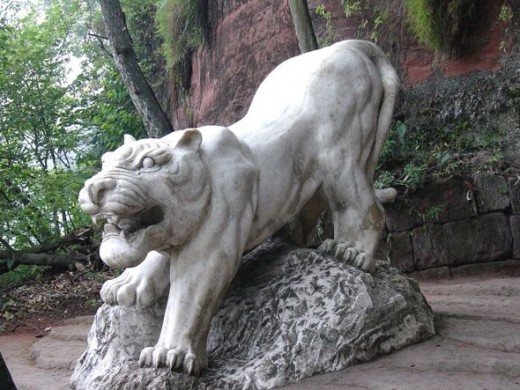
Image of White Tiger Statue on Flickr by... drs2biz!
"Lingyun hill, with dense forests and parks, provided in ancient times a good shelter to a white tiger, while at the foot of the hill the three rivers Mingjiang, Dado and Qingyi met and provided a black dragon with waves for play. It was said that the white tiger and black dragon, inspired by Buddhist sculptures, changed themselves into a stone dragon and a jade tiger to guard Buddhism. In Buddhist scriptures, the dragon and the tiger are regarded as guardian angels. Cen Shen, a poet and governor of Jiazhou, wrote during a visit to Lingyun Hill: 'Wind blows over the tiger lair, raindrops to fill the dragon pool'. This site, later named Dragon Pool and Tiger Lair, has been one of the scenic spots in Lingyun Hill since the Tang Dynasty."
Cen Shen (715-770 AD): drs2biz!
Add Your Comments
Leave a comment in our Guest Book
Other Buddhas At This Park:
Seen in the many temples, pavilions and halls!
View The Big-belly Arhat at Doushuai Hall!
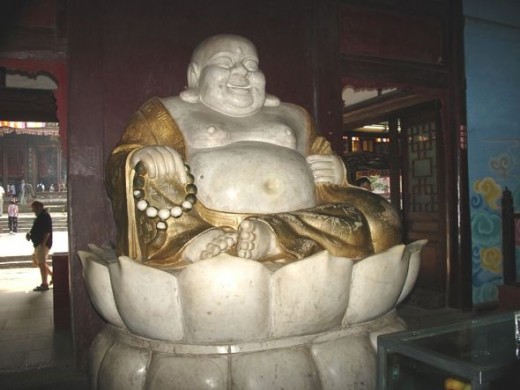
Image of "Big-belly Arhat" on Flickr by... drs2biz!
"Doushuai", a transliteration from Sanskrit, means satisfaction or appreciation. Doushuai Hall is the residence of Matreya.According to the Records of the Buddha, during the period of the Five Dynasties, there was a fat monk named Xie Ci who used to carry a sack with him and tell fortunes . At the time he was going to die, he murmured in gatha again and again: "Matreya is really great. he has millions upon millions images". This fat monk was thus regarded later as a figure of Matreya. This image was established in the Ming Dynasty. It is also called "Big-belly Arhat"
Doushuai Hall is located just before visitors reach the viewing area of the Leshan Giant Buddha and you pass through this area to reach the main statue.
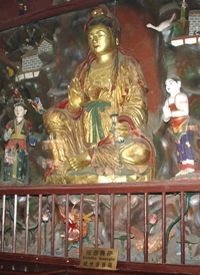
Guanyin Buddha Statue in Giant Buddha Temple!
Buddha Guanyin is one of the "3 Saints in the West".
Guanyin, or "Guanshiyin", is translated from Sanskrit "Avolokitesvara". In the Buddhist scripture, it says that Guanyin is the Buddha of Mercy who can magically change himself into 33 different figures, and save people from 12 unbearable disasters and lead them to the Western Paradise.
Mount Putuo is Guanyin's Sanctum.
Guanyin (Avalokitesvara) is an important Buddhist image in China. To view further details of this revered figure, have a look at this lens on Nanshan Buddhism Cultural Park!
Guanyin Statue Image: drs2biz!
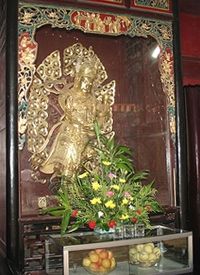
Sakyamuni Statue at Temple Near Giant Buddha!
Sakyamuni is said to have three bodies named Fashen, Baoshen and Yingshen, relatively referring to images of Buddhist doctrines, intelligence and virtues.
- Fashen - Pilushena, a transliteration from Sanskrit "Mahavairocana", which means Buddhism illuminating all over the world.
- Baoshen - Lushena, a transliteration from Sanskrit "Vairocana", which means intelligence in saving oneself.
- Yingshen - Sakyamuni, the common image of the Grand Buddha that advocates social virtues or good deeds.
Sakyamuni Statue by: drs2biz!
Before the Five Dynasties, there used to be 16 figures of them in the temple. In the Song Dynasty two were added in. It was said that Sakyamuni asked his disciples to remain on the earth to safeguard Buddhism and serve mankind.
Statues of Buddha Wenshu & Buddha Dashizhi!
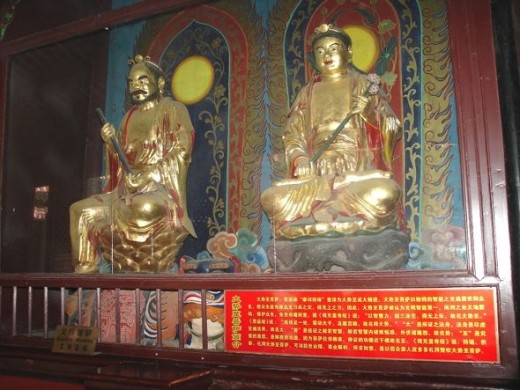
Buddha Wenshu is one of the four big Buddhas in Chinese temples.
"Wenshu" or "WenshuShill", a transliteration from Sanskrit "Munjurri"", means virtues or good fortunes. Because of his high wisdom, Wenshu is regarded as Mother and teacher of Buddhas according to Huayan Scriptures.
Mount Wutai, in Shanxi, is Wenshu's sanctum.
"Dashizhi", a transliteration from Sanskrit "Mahasthamaprapta" (most powerful).
The Buddhist scripture says that Dasizhi is so named because the Buddha illuminates all over the world with his wisdom and makes the Three Evils less powerful. Together with Guanyin, he keeps Amituofu's (Amitabha's) company, and all of the three are regarded as "Three Saints in the West".
Statues of Buddha Dicang & Buddha Puxian!
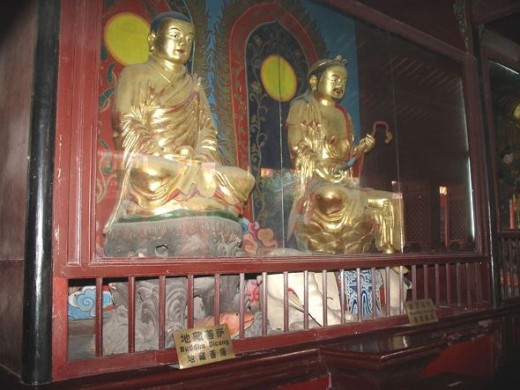
Buddha Dicang (LH Statue) is one of the four big Buddhas in Chinese temples.
"Dicang", a transliteration from Sanskrit "Ksitigarbha" means to bear tortures deep in the heart and to be as calm as the earth. Asked by Sakyamuni to save people, Dicang vowed not to be a Buddha until he had successfully led everyone to leave their sins. For this, he has been regarded as a Buddha who saves people when they are living and after their death as well. Mount Jiuhua is his Sanctum.
Buddha Puxian (RH Statue) is one of the four big Buddhas in Chinese temples.
"Puxian", a translation from Sanskrit "Samantabhadra", means universal philanthropy. According to Buddhist scriptures, Puxian represents actions or hard work, for he devotes himself to both Buddhism and to the education of the people.
In the Buddhist world, Mount Emei is recognised as his Sanctum.
Gods From East and West With Attendant Monk
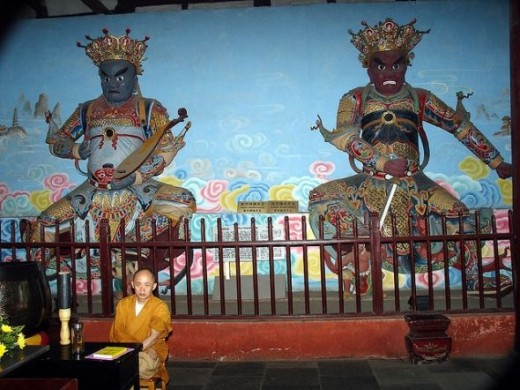
Add Your Comments
Leave a comment in our Guest Book
Did you enjoy reading about the Leshan Giant Buddha? Leave your comments and questions below. Please take the time to rate this lens a "thumbs up" at the top LH corner of the page. If you enjoyed it, you may care to mark it as a favourite as well. Not a Squidoo member yet? You're missing out on all the fun. Squidoo is free to join and use, and you can even make some money for your favourite charity, our even for yourself (gasp). Go ahead, make my day and make your first lens now.
Image: Greekgeek

